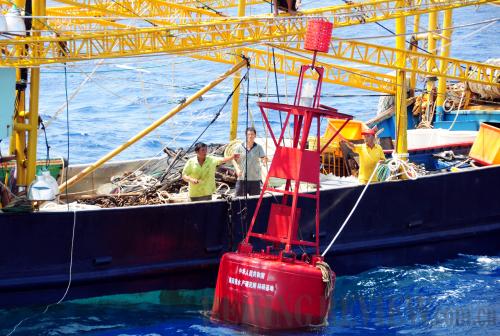|
 |
|
DEEP-SEA STUDY: Researchers install a buoy at a maritime fishery resource breeding and research base in waters of the Zhongsha Islands on June 27. It is the first scientific program approved in Sansha since the city's establishment (XIA GUANNAN) |
Tapping the potential
As part of Sansha's efforts to boost its development, the city has introduced 13 doctorate holders from the State Oceanic Administration, universities and renowned research institutions to work in various local government departments.
Xiao awarded them letters of appointment on July 22.
Scholars of South China Sea studies, marine biology, environmental protection, land planning and fisheries will work as assistants to the heads of their respective departments for one year.
Local officials said that more talented people will be introduced to Sansha in coming years.
In a June interview with International Tourism Island Business Daily, Xiao said that he expects higher government authorities will make exceptions to household registration requirements to attract more long-term residents with diverse occupations.
The establishment of Sansha has generated the public's interest in this area. The first group of Chinese tourists aboard a cruise ship sailed to Xisha Islands on April 28.
Some 240 Chinese passengers paid between 7,000 ($1,100) and 9,000 yuan ($1,500) for the four-day trip from the Hainan Island to two of the Xisha Islands for sightseeing.
Cruises can minimize visitors' damage to the environment, which is important for Sansha, said Lu Zhiyuan, Director of the Hainan Provincial Tourism Administration.
With its maiden voyage a complete success, cruise tickets are being sold at major travel agencies and is scheduled to depart once or twice a month.
Xiao told magazine Outlook Weekly in May that Sansha has complied with the Central Government for better protection of relics along the ancient Marine Silk Route, a historical network of interlinking trade routes between China and Western countries, including shipwrecks carrying exported porcelain, and settlements established by Chinese inhabitants as early as 1,000 years ago.
"These heritage sites are important proof of Chinese ancestors' early development of the South China Sea. Protecting them is significant for our studies on history and development of tourism," Xiao said.
Email us at: lili@bjreview.com
| 